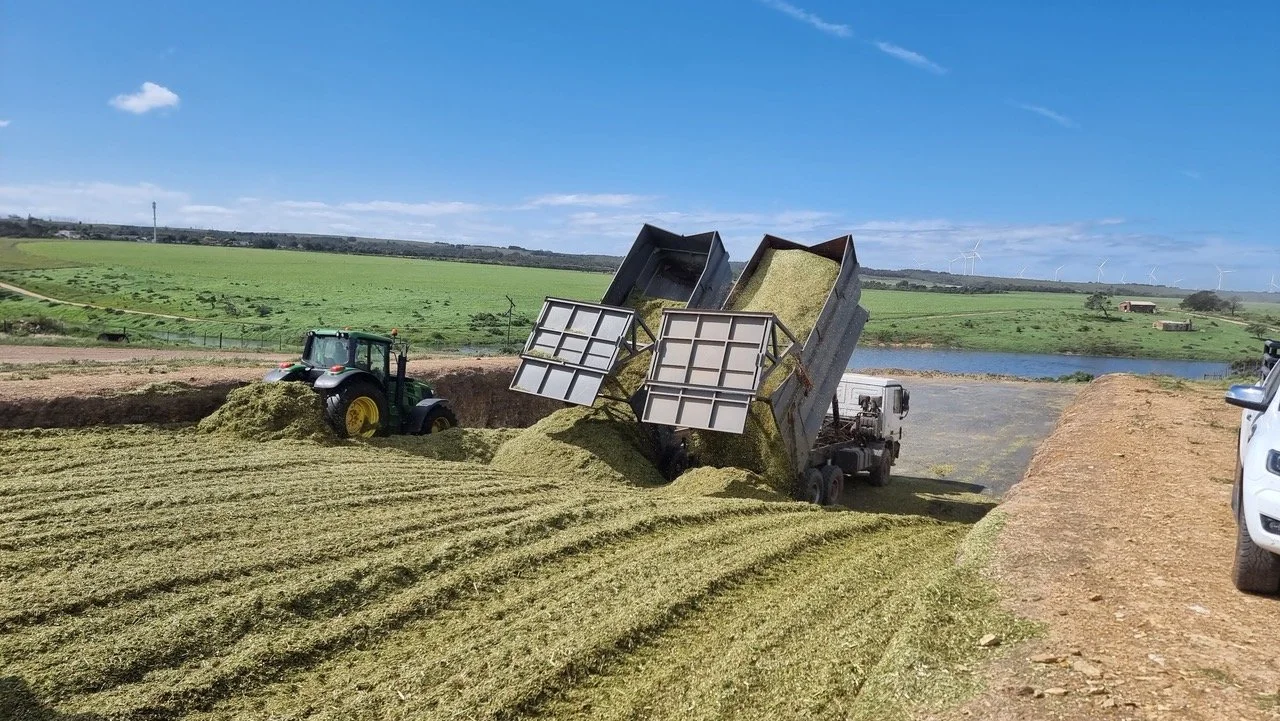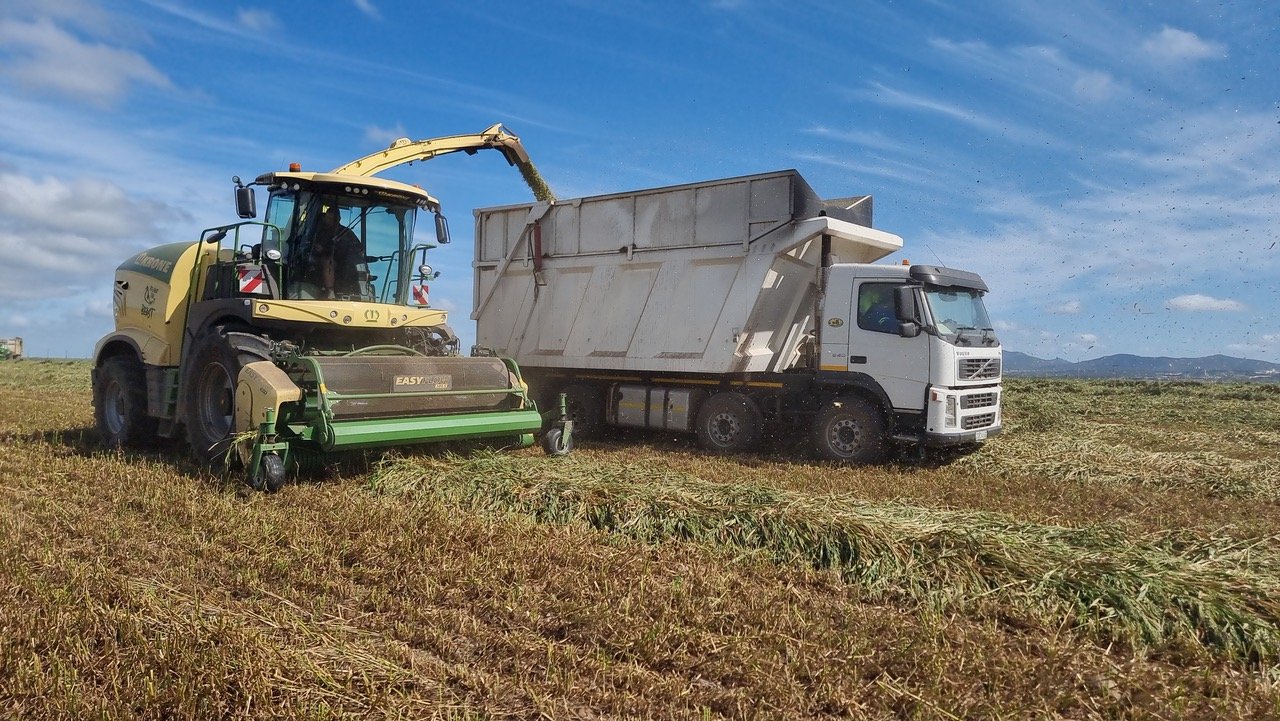For South African dairy farmer, Bull van Rensburg, silage is a supplement to year-round grazing – rather than a sole winter forage. Nevertheless, he still wants to improve it to drive down costs.
Home to 1,200 dairy cows, Bull van Rensburg’s 1,000ha Groenwei Boerdery (which translates as Green Grazing Farming) business, near Port Elizabeth in the Eastern Cape, has a coastal climate that is near perfect for year-round pasture.
Even in winter there is always grass available. And although cooler winter temperatures mean grass growth may be slower than at other times of the year, it is not cold enough for frosts.
Typically, therefore, silage is mainly used to top up grazing for milking cows during those cooler winter periods and during summer when drought becomes an issue. Some farms also feed silage to dry cows.
The cows stay on pasture all year,” explains Mr van Rensburg. “They are never housed. Winter temperatures range from 15-19 deg C. Summer temperatures average 25-30 deg C.
“The more pasture we can graze the better, but as soon as grass quality and quantity declines because of growth through the season or drought, we have to feed silage.
Our grazing cycle is we graze for 25-30 days, or that might reduce to 20 days, then the surplus grazing we put into silage. But the main silage crop is grown on dedicated land.
Average milk yield at Groenwei Boerdery is about 7,500 litres/cow. Some 60% of the cows are USA/Canadian type Holsteins, yielding about 9,500 litres. The remaining 40% are Jerseys producing about 6,500 litres. Cows are year-round calved for flat rate milk production, with milk sold onto the liquid market.
“With input costs and milk price, we’re not making much return on capital,” says Mr van Rensburg. “Input costs are running away – for example fertiliser and concentrate price.
We feed a lot of concentrate. My aim is to get my silage protein as high as possible.
With this in mind, lucerne is increasingly being included in pastures to provide protein and to reduce fertiliser use. As well as making grass-based silage, wholecrop silage is also produced using a sown mixture of oats and triticale.
According to MC Veldsman, a South African forage advisor and contractor, oats produce better quality silage and more yield than other wholecrop cereals in South Africa. Maize is also a big silage crop. Between them, he says maize and wholecrop oats account for about 80% of all silage made in the region. Other silage crops include sorghum and ryegrass, he notes.
Being on fairly shallow, shale-type soil means Mr van Rensburg’s farm is too dry for an oats-only wholecrop, which is why triticale is included. Annual rainfall on the farm is around 650mm, and around 300 of the 1,000ha are irrigated.
Cutting grass for silage starts in the South African spring, which is during September to November. Mr van Rensburg’s grass and wholecrop silages are fed in a feed pen, with concentrates of wholegrain maize pellets and soya, plus minerals, fed in out-of-parlour feeders using a computerised system according to cow size and milk yield.
“We put high attention to detail into getting the best quality out of silage crops,” Mr van Rensburg continues. “Originally, we didn’t use an inoculant. Then we tried some inoculant and saw improvements in milk yield and in the stability of the silage, plus reduced silage losses.”
As well as using an additive, silage compaction in the clamp or bunker is being improved, and the farm is looking at how to better manage the silage face at feedout to reduce wastage. All these are geared to making better silage as a way of reducing feed costs. “I am saving more by using an additive. I’m also reviewing different additives to choose one which works in my situation – I’m considering Ecosyl or Ecocool,” he adds.
We’re still not getting the milk from forage that we are hoping for, so my thinking is also to combine feeding lucerne pasture with feeding silage, and to get a higher metabolisable energy from the oats.
“With higher fertiliser costs, the value of slurry has increased, so we’re also making better use of slurry,” he adds.
Study tour
Bull van Rensburg and MC Veldsman were among a group of South African farmers and silage experts who took part in a study tour to the UK organised by Volac.
As well as farm visits, the tour also visited Volac’s Ecosyl research and manufacturing facilities in Port Talbot, South Wales.
Volac’s silage experts explained how the MTD/1 bacteria in Ecosyl bring about efficient silage fermentations, with results showing reduced silage dry matter losses, improved preservation of metabolisable energy and true protein, and ultimately, across a range of forages preserved with Ecosyl, an average of an extra 1.2 litres of milk/cow/day.
Like the UK, South Africa is among an increasing number of countries around the world where we are seeing increased interest in making better silage,” explained Volac global forage product manager, Jackie Bradley. “South African farmers are very knowledgeable about making silage.
“In part, the drive for better silage is down to increased feed costs, which are a global issue. But in some counties it is also being driven by forage crops increasingly being used for energy production, for example in anaerobic digesters. This is reducing the amount of forage available for livestock, which has made it even more important that losses in silage for animal feed are kept to an absolute minimum,” Mrs Bradley adds.
Article first published in British Dairying, August 2023.
If you would like to stay up-to-date on the latest news and expert advice on making consistently better silage, sign up to our newsletter today.






